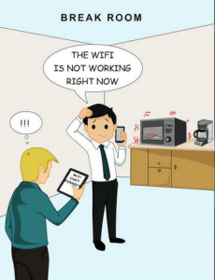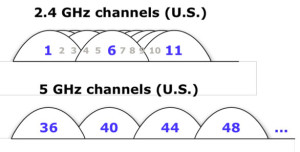Posted by Babar Hashim, August 20, 2015
Why you need Dual Band Wi-Fi?
 People have become very dependent on Wi-Fi networks, and reliable Wi-Fi performance is something that is expected. How many times do you find yourself experiencing slow downloads, or connection issues?
People have become very dependent on Wi-Fi networks, and reliable Wi-Fi performance is something that is expected. How many times do you find yourself experiencing slow downloads, or connection issues?
Wireless devices run on one of two frequencies – 2.4 GHz and 5.0 GHz. The biggest differences between the two are the range, bandwidth, and amount of Interference.
Lately the 2.4 GHz frequency has been over saturated with high numbers of wireless devices, causing all these devices to compete for bandwidth. This has prompted users to utilizing the 5GHz frequency band. One big advantage of using the 5 GHz band is:
- 2.4 GHz has only 3 non-overlapping channels (1,6, and 11).
- However, 5 GHz has 23 non-overlapping channels to provide to these wireless devices.

Other reasons to consider dual-band Wi-Fi for your applications are:
- Less Interference
The 2.4 GHz frequency is the same band used by an assortment of other electronic devices in a home, such as cordless phones, wireless keyboards and mice, Bluetooth headsets, intercoms, baby monitors, and even microwaves. Any one of these devices can cause interference.
The 5 GHz band also has fewer non-overlapping channels, which is ideal for anyone who lives in a crowded apartment building where several networks exist. Even if your neighbors do have a network that uses the 5 GHz frequency, the odds of you sharing a channel are much less.
- Reliable Streaming
Since the 5 GHz band is less crowded, you can devote that to streaming and not have to worry about lag, pixilation, and other quality issues, and leave the 2.4 GHz band for general Internet browsing.
For the reasons stated above, more and more users have started to utilize the 5 GHz band. In fact according to an ABI research study, the use of dual-band Wi-Fi devices using 2.4 GHz and 5 GHz spectrum has surpassed that of single-band 2.4 GHz devices. According to ABI's report, 68 percent of all Wi-Fi devices shipped in 2015 will use the 5 GHz band.
The 5 GHz band is far less prone to crowding and interference than the 2.4 GHz band, and more importantly, it has a lot more spectrum available to use. So it is safe to state that device manufacturers who plan to incorporate Wi-Fi into their devices should seriously consider the use of dual band radios, especially if their application requires reliable and robust connection to the network.
At Silex we pride ourselves to transform products into reliable wireless devices and machines that deliver a completely connected, always-on experience for your customers. To get a complete listing of our offerings please visit our website, or contact our sales team to assist you with your wireless needs.

%20_300dpi.jpg?width=300&height=300&name=AP-800AX(2000x2000)%20_300dpi.jpg)